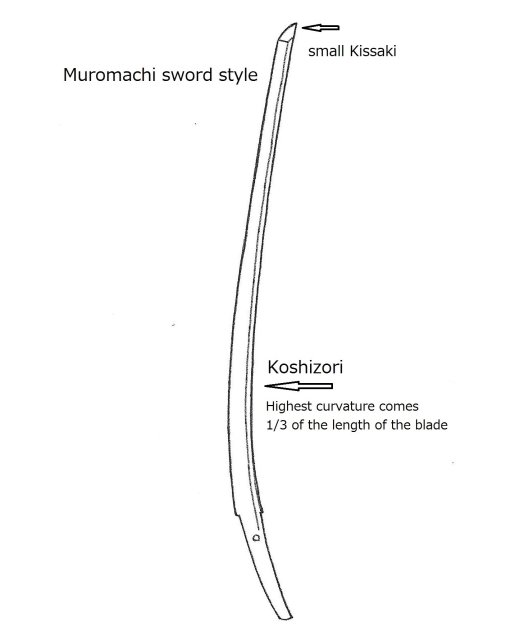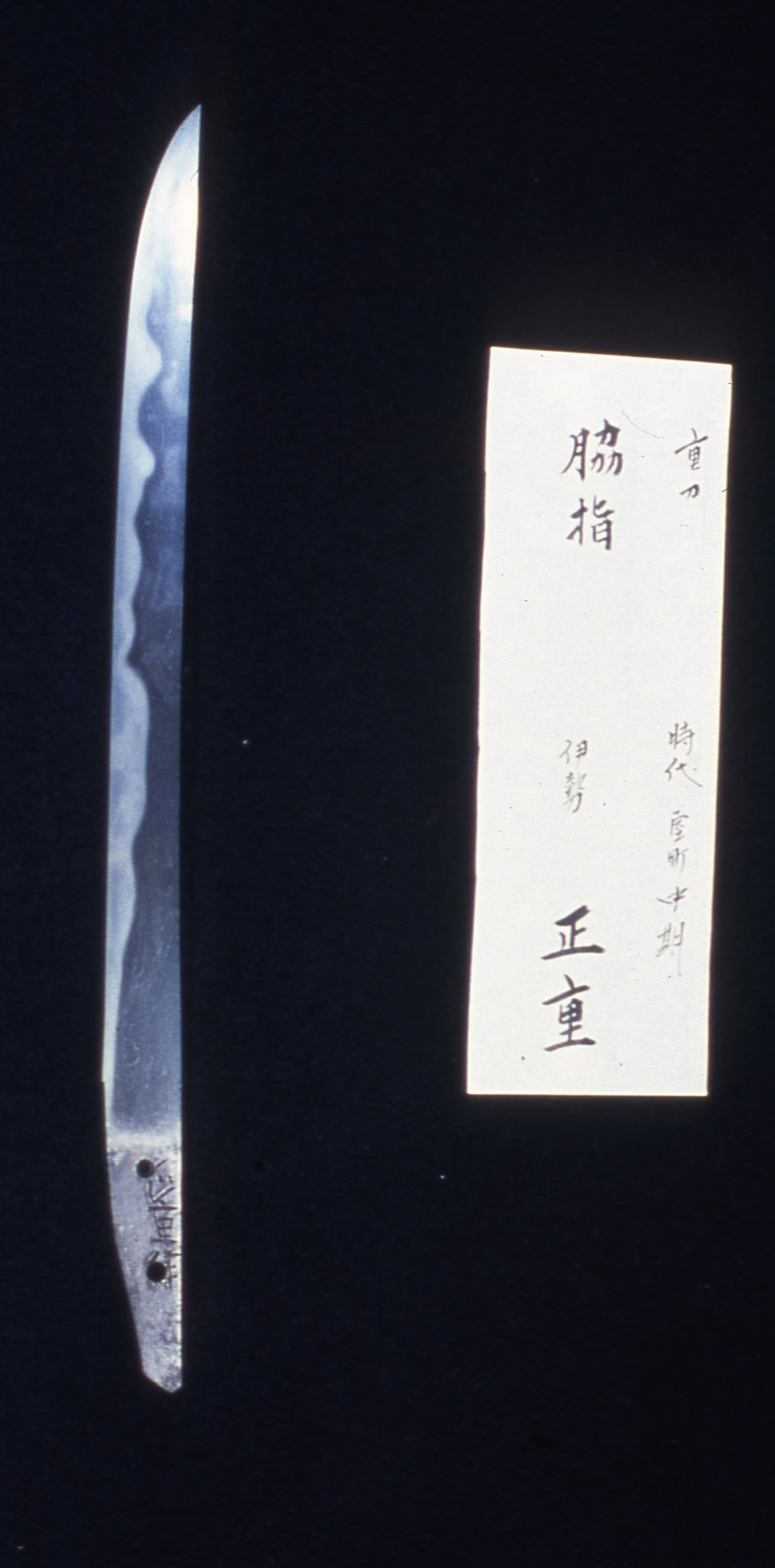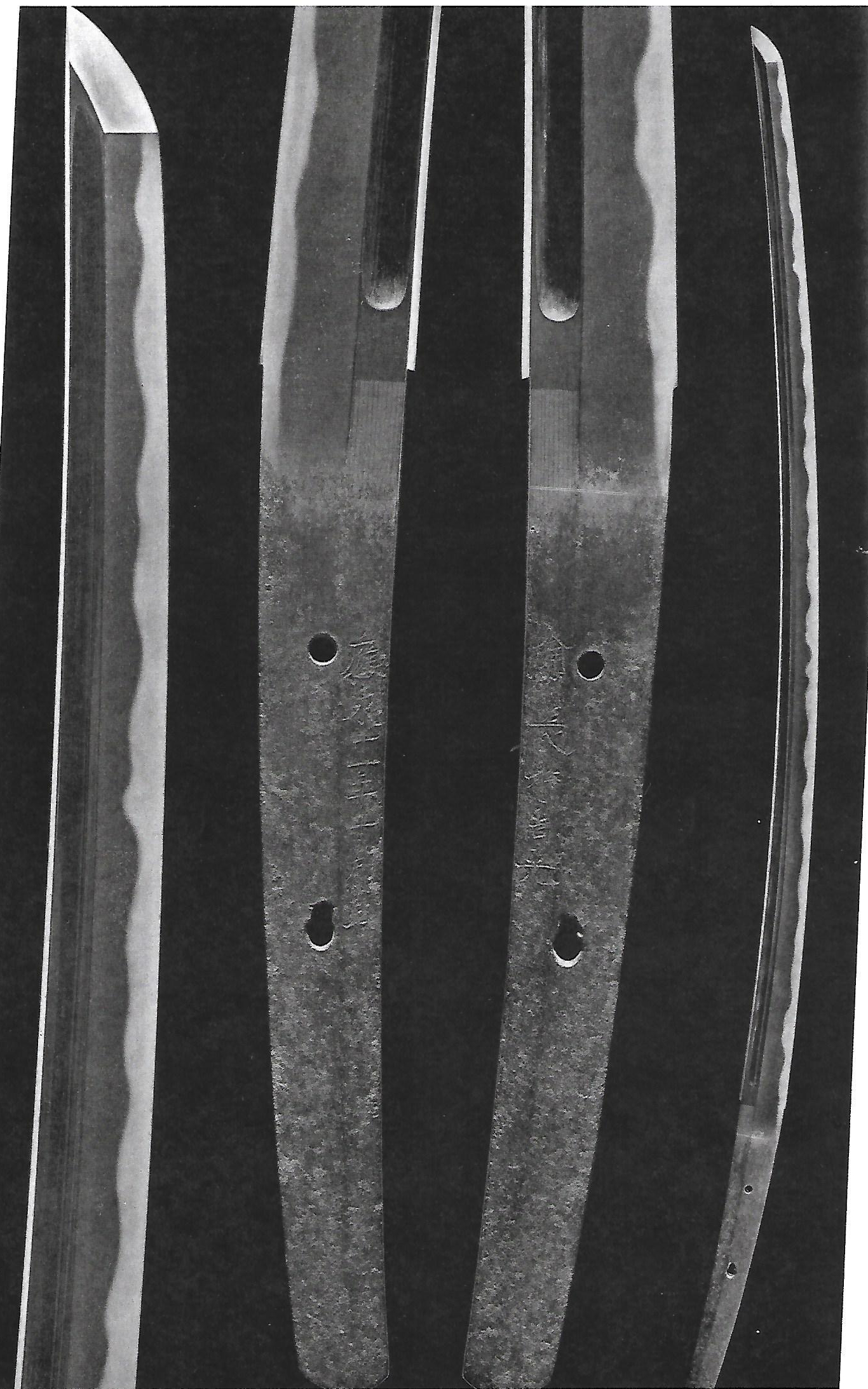
The red circle above indicate the time we discuss in this section
The Muromachi period was a relatively peaceful and prosperous time until a little before “Onin-no-Ran,” which happened at the end of the Muromachi Period. Refer to Chapter 20|Muromachi Period History (室町時代歴史) . The Nanboku-cho style long sword became useless; thus, they were shortened. The shortened blade is called Suriage. In general, the Muromachi period was the declining time for sword making.
Tachi and Katana
Until the end of the Nanboku-cho period or the beginning of the Muromachi period, Samurai suspended swords from one’s waist, the blade side down. When a sword was worn this way, the swordsmith inscribed his name to the side that faces outward, which means that the blade comes on your right when you see the inscription. In this case, the sword is called Tachi.
Yet, around the Muromachi period, a sword was worn between one’s belt, with the blade side up. The swordsmiths inscribed his name to face outward when it was worn. Therefore, when you see the inscription, the cutting edge comes on your left. Then it is classified as Katana.
Around the beginning of the Muromachi period, Samurai started to wear a pair of swords called Dai-sho (大小), meaning large and small. The long one is Katana, and the short one is Wakizashi. In general, Tachi is longer than Katana. Katana is longer than Wakizashi, and Wakizashi is longer than Tanto. Here is the order of the length.
Tachi > Katana > Wakizashi > Tanto
The difference between Tachi and Katana comes from the way it was worn, not the length. 
O-suriage ( 大磨上: Katana shortened by great length)
How much the sword should be shortened depends on the sword’s original length and how much the owner wants it shortened. O-suriage is a kind of sword that is shortened by a great length. Once a blade is shortened that much, the inscription of the maker’s name is cut off. When Hon’ami family (本阿弥家, a sword connoisseur family who have appraised Japanese swords for generations since the Muromachi period till today) appraised such a Suriage sword, they wrote the make of the sword and the swordsmith’s name on the front side of the hilt, and the connoisseur’s name with his Kaou (similar to signature) on the back. There are several ranks of writings. Which level it should be done is depending on the quality of the sword and how an owner wants it. Below are the classes (lower to highest).
Shu-Mei (朱明 )————————————————————-name written in Vermilion Kinpun-Mei (金粉名 )———————————————–name lacquered in gold powder Gin-Zougan (銀象嵌 )————————————————————name inlaid in silver Kin-Zougan (金象嵌 )————————————————————-name inlaid in gold
Sugata (姿: Shape)———— The average length is usually 2 feet and 3 to 4 inches (68~71cm). The shape of the Muromachi period Katana is somewhat similar to the Heian period Tachi style. However, Muromachi Katana is not as grand or graceful as the Heian period sword. The curvature is usually the Koshizori shape. Koshizori means the highest curvature comes at the lower part of the blade. The length and shape are suitable for wearing between the body and the belt. The width and the thickness are well balanced with the size of the sword. Small Kissaki.

Hirazukuri-Wakizashi———–Hirazukuri means a flat surface with no Shinogi and no Yokote line. Usually One foot and 1, 2 inches long. No curvature. Hirazukuri-Wakizashi appeared during the Muromachi time.
Hamon (刃文: tempered line) ———————- Nioi base. Tempered area is well balanced to the width of the blade. Koshi-hiraita-midare mixed with Choji-midare.

- Boshi (Tempered line at Kissaki area) ————– Midare-komi, short turn back. See the above illustration. Midare is an irregular wave-like pattern.
- Ji-hada (地肌: An area between the tempered line and Shinogi————Soft look, large wood grain pattern, Ji-utsuri (faint smoke or cloud-like effect) shows.
- Horimono (彫物:Engravings) ———- Bo-hi (single groove), Soe-hi (Hi accompanied with a thin groove), Futasuji- hi (double narrow groove), Sanskrit, Tokko-tsuki ken, Tsume-tsuki Ken, name of God, and dragon. Carvings became elaborate.


Sword Smiths during Muromachi Period
- Bizen Den ——–Osafune Morimitsu (長船盛光), Yasumitsu (康光), Moromitsu (師光)
- Yamashiro Den————————————————-Yamashiro Nobukuni (山城信国)


Ise Masashige (伊勢正重), Bizen Osafune Naomitsu (備前長船尚光) Juyo Token(重要刀剣) Sano Museum Catalogue (permission granted) once my family sword
Hello. I really enjoyed your paper and greatly appreciated the way that you presented it. I have been struggling with finding out who the sword smith was on a wonderful tanto that I discovered from the above mentioned period. I would greatly appreciate it if you would take a moment to view the tanto and signature. I will send the images abboone your approval.
Regards
Eric Sheffield
LikeLike
Maybe yu can send me the photo of the Nakago area.
I can not promise I can tell, but at lease I can try.
Yurie
LikeLike
Thank you again. I have forwarded you a link through comments. Please let me know if you didn’t receive it or it does not work.
Regards
Eric
LikeLike
Thank you so much for your time. Please let me know if you have trouble with the link below. It was the only way that I could figure out how to get the image to you. It’s through IMGUR.
Regards;
Eric
LikeLike
It looks like it says,
備前長船住[?] [?] (Bizen Osafune Jyu [?] [?] ).
[?] [?] is not readable.
Please don’t quote me on this. It is only by the picture.
I don’t want to take responsibility.
Yurie
LikeLike
Thank you so much for your time and translation. I will dig deeper into it over time and figure this one out. It’s so special to think that this sword was being created when so much of the rest of the world was still so crude. The Japanese culture is so special to me and yet I have never been to japan.
Thank you again
Eric Sheffield.
On Tue, Feb 5, 2019 at 2:54 PM Study of Japanese Sword wrote:
> Yurie Endo 遠藤由利江 commented: “It looks like it says, 備前長船住[?] [?] (Bizen > Osafune Jyu [?] [?] ). [?] [?] is not readable. Please don’t quote me on > this. It is only by the picture. I don’t want to take responsibility. Yurie > ” >
LikeLike
Good morning Yuri san
I have recently found your paper and find it very informative and easy to digest . Please continue to write, do you have a website i can visit.
I am a iaido practitioner and a recent member of the english Token society
Thank you for passing on your knowledge
Robert (london)
LikeLike
I sent you an Email to your Email address, bobtrend@btinternet.com.
LikeLike
Domo arigatou sensei
Shitsureishimasu
On Sat, 24 Oct 2020 at 9:54 am Study of Japanese Sword wrote:
> Yurie Endo 遠藤由利江 posted: ” The circle indicate the time we are discussing > in this section The Muromachi period was a relatively peaceful and > prosperous time until a little before “Onin-no Ran,” which was the later > part of the Muromachi Period. Refer 20|Muromachi Pe” >
LikeLike
hi Yurie, just came across your book and was planning to buy with Hard cover and apparently Alphobook publisher doesn’t ship to canada, really would prefer harcover over the soft .if you can help with that i am in British Columbia.
also i would love to ask your opinion on a blade i just inherited if you want to contact me directly on y email that would be awesome ( looks to be muromachi era but my knowledge is still limited)
thanks
Michael
LikeLike
Alpha book publisher fix the order link. They should be able to ship the hardcover to Canada now. If you still have a problem, please write to them in the “Contact us” tab at the bottom right or top tab.
LikeLike